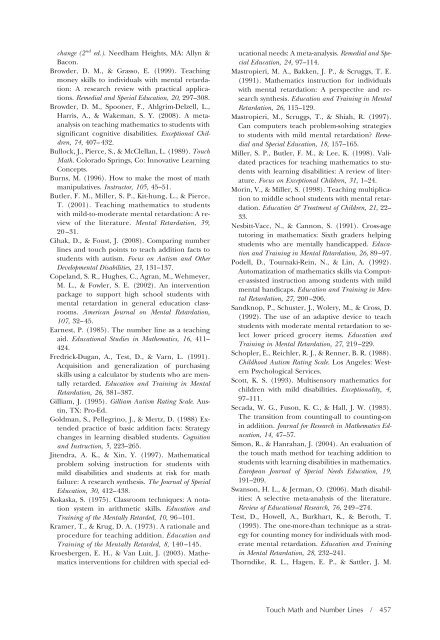Education and Training in Autism and Developmental Disabilities
Education and Training in Autism and Developmental Disabilities
Education and Training in Autism and Developmental Disabilities
Create successful ePaper yourself
Turn your PDF publications into a flip-book with our unique Google optimized e-Paper software.
change (2 nd ed.). Needham Heights, MA: Allyn &<br />
Bacon.<br />
Browder, D. M., & Grasso, E. (1999). Teach<strong>in</strong>g<br />
money skills to <strong>in</strong>dividuals with mental retardation:<br />
A research review with practical applications.<br />
Remedial <strong>and</strong> Special <strong>Education</strong>, 20, 297–308.<br />
Browder, D. M., Spooner, F., Ahlgrim-Delzell, L.,<br />
Harris, A., & Wakeman, S. Y. (2008). A metaanalysis<br />
on teach<strong>in</strong>g mathematics to students with<br />
significant cognitive disabilities. Exceptional Children,<br />
74, 407–432.<br />
Bullock, J., Pierce, S., & McClellan, L. (1989). Touch<br />
Math. Colorado Spr<strong>in</strong>gs, Co: Innovative Learn<strong>in</strong>g<br />
Concepts.<br />
Burns, M. (1996). How to make the most of math<br />
manipulatives. Instructor, 105, 45–51.<br />
Butler, F. M., Miller, S. P., Kit-hung, L., & Pierce,<br />
T. (2001). Teach<strong>in</strong>g mathematics to students<br />
with mild-to-moderate mental retardation: A review<br />
of the literature. Mental Retardation, 39,<br />
20–31.<br />
Cihak, D., & Foust, J. (2008). Compar<strong>in</strong>g number<br />
l<strong>in</strong>es <strong>and</strong> touch po<strong>in</strong>ts to teach addition facts to<br />
students with autism. Focus on <strong>Autism</strong> <strong>and</strong> Other<br />
<strong>Developmental</strong> <strong>Disabilities</strong>, 23, 131–137.<br />
Copel<strong>and</strong>, S. R., Hughes, C., Agran, M., Wehmeyer,<br />
M. L., & Fowler, S. E. (2002). An <strong>in</strong>tervention<br />
package to support high school students with<br />
mental retardation <strong>in</strong> general education classrooms.<br />
American Journal on Mental Retardation,<br />
107, 32–45.<br />
Earnest, P. (1985). The number l<strong>in</strong>e as a teach<strong>in</strong>g<br />
aid. <strong>Education</strong>al Studies <strong>in</strong> Mathematics, 16, 411–<br />
424.<br />
Fredrick-Dugan, A., Test, D., & Varn, L. (1991).<br />
Acquisition <strong>and</strong> generalization of purchas<strong>in</strong>g<br />
skills us<strong>in</strong>g a calculator by students who are mentally<br />
retarded. <strong>Education</strong> <strong>and</strong> <strong>Tra<strong>in</strong><strong>in</strong>g</strong> <strong>in</strong> Mental<br />
Retardation, 26, 381–387.<br />
Gilliam, J. (1995). Gilliam <strong>Autism</strong> Rat<strong>in</strong>g Scale. Aust<strong>in</strong>,<br />
TX: Pro-Ed.<br />
Goldman, S., Pellegr<strong>in</strong>o, J., & Mertz, D. (1988) Extended<br />
practice of basic addition facts: Strategy<br />
changes <strong>in</strong> learn<strong>in</strong>g disabled students. Cognition<br />
<strong>and</strong> Instruction, 5, 223–265.<br />
Jitendra, A. K., & X<strong>in</strong>, Y. (1997). Mathematical<br />
problem solv<strong>in</strong>g <strong>in</strong>struction for students with<br />
mild disabilities <strong>and</strong> students at risk for math<br />
failure: A research synthesis. The Journal of Special<br />
<strong>Education</strong>, 30, 412–438.<br />
Kokaska, S. (1975). Classroom techniques: A notation<br />
system <strong>in</strong> arithmetic skills. <strong>Education</strong> <strong>and</strong><br />
<strong>Tra<strong>in</strong><strong>in</strong>g</strong> of the Mentally Retarded, 10, 96–101.<br />
Kramer, T., & Krug, D. A. (1973). A rationale <strong>and</strong><br />
procedure for teach<strong>in</strong>g addition. <strong>Education</strong> <strong>and</strong><br />
<strong>Tra<strong>in</strong><strong>in</strong>g</strong> of the Mentally Retarded, 8, 140–145.<br />
Kroesbergen, E. H., & Van Luit, J. (2003). Mathematics<br />
<strong>in</strong>terventions for children with special ed-<br />
ucational needs: A meta-analysis. Remedial <strong>and</strong> Special<br />
<strong>Education</strong>, 24, 97–114.<br />
Mastropieri, M. A., Bakken, J. P., & Scruggs, T. E.<br />
(1991). Mathematics <strong>in</strong>struction for <strong>in</strong>dividuals<br />
with mental retardation: A perspective <strong>and</strong> research<br />
synthesis. <strong>Education</strong> <strong>and</strong> <strong>Tra<strong>in</strong><strong>in</strong>g</strong> <strong>in</strong> Mental<br />
Retardation, 26, 115–129.<br />
Mastropieri, M., Scruggs, T., & Shiah, R. (1997).<br />
Can computers teach problem-solv<strong>in</strong>g strategies<br />
to students with mild mental retardation? Remedial<br />
<strong>and</strong> Special <strong>Education</strong>, 18, 157–165.<br />
Miller, S. P., Butler, F. M., & Lee, K. (1998). Validated<br />
practices for teach<strong>in</strong>g mathematics to students<br />
with learn<strong>in</strong>g disabilities: A review of literature.<br />
Focus on Exceptional Children, 31, 1–24.<br />
Mor<strong>in</strong>, V., & Miller, S. (1998). Teach<strong>in</strong>g multiplication<br />
to middle school students with mental retardation.<br />
<strong>Education</strong> & Treatment of Children, 21, 22–<br />
33.<br />
Nesbitt-Vacc, N., & Cannon, S. (1991). Cross-age<br />
tutor<strong>in</strong>g <strong>in</strong> mathematics: Sixth graders help<strong>in</strong>g<br />
students who are mentally h<strong>and</strong>icapped. <strong>Education</strong><br />
<strong>and</strong> <strong>Tra<strong>in</strong><strong>in</strong>g</strong> <strong>in</strong> Mental Retardation, 26, 89–97.<br />
Podell, D., Tournaki-Re<strong>in</strong>, N., & L<strong>in</strong>, A. (1992).<br />
Automatization of mathematics skills via Computer-assisted<br />
<strong>in</strong>struction among students with mild<br />
mental h<strong>and</strong>icaps. <strong>Education</strong> <strong>and</strong> <strong>Tra<strong>in</strong><strong>in</strong>g</strong> <strong>in</strong> Mental<br />
Retardation, 27, 200–206.<br />
S<strong>and</strong>knop, P., Schuster, J., Wolery, M., & Cross, D.<br />
(1992). The use of an adaptive device to teach<br />
students with moderate mental retardation to select<br />
lower priced grocery items. <strong>Education</strong> <strong>and</strong><br />
<strong>Tra<strong>in</strong><strong>in</strong>g</strong> <strong>in</strong> Mental Retardation, 27, 219–229.<br />
Schopler, E., Reichler, R. J., & Renner, B. R. (1988).<br />
Childhood <strong>Autism</strong> Rat<strong>in</strong>g Scale. Los Angeles: Western<br />
Psychological Services.<br />
Scott, K. S. (1993). Multisensory mathematics for<br />
children with mild disabilities. Exceptionality, 4,<br />
97–111.<br />
Secada, W. G., Fuson, K. C., & Hall, J. W. (1983).<br />
The transition from count<strong>in</strong>g-all to count<strong>in</strong>g-on<br />
<strong>in</strong> addition. Journal for Research <strong>in</strong> Mathematics <strong>Education</strong>,<br />
14, 47–57.<br />
Simon, R., & Hanrahan, J. (2004). An evaluation of<br />
the touch math method for teach<strong>in</strong>g addition to<br />
students with learn<strong>in</strong>g disabilities <strong>in</strong> mathematics.<br />
European Journal of Special Needs <strong>Education</strong>, 19,<br />
191–209.<br />
Swanson, H. L., & Jerman, O. (2006). Math disabilities:<br />
A selective meta-analysis of the literature.<br />
Review of <strong>Education</strong>al Research, 76, 249–274.<br />
Test, D., Howell, A., Burkhart, K., & Beroth, T.<br />
(1993). The one-more-than technique as a strategy<br />
for count<strong>in</strong>g money for <strong>in</strong>dividuals with moderate<br />
mental retardation. <strong>Education</strong> <strong>and</strong> <strong>Tra<strong>in</strong><strong>in</strong>g</strong><br />
<strong>in</strong> Mental Retardation, 28, 232–241.<br />
Thorndike, R. L., Hagen, E. P., & Sattler, J. M.<br />
Touch Math <strong>and</strong> Number L<strong>in</strong>es / 457

















